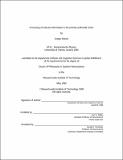Processing of relevant information in the primate prefrontal cortex
Author(s)
Rainer, Gregor, 1970-
DownloadFull printable version (52.24Kb)
Other Contributors
Massachusetts Institute of Technology. Dept. of Brain and Cognitive Sciences.
Advisor
Earl K. Miller.
Terms of use
Metadata
Show full item recordAbstract
Extracellular recordings of neural activity were made in areas around and ventral to the principal sulcus of the lateral prefrontal (PF) cortex in two monkeys (macacca mulatta). Activity was assessed during the performance of three visual memory tasks. In the first task, the sensory and mnemonic receptive fields were studied, by requiring monkeys to simultaneously remember both the identity and the location of an object presented at different locations. We report that many conveyed both object and spatial information during the sensory and mnemonic period. Receptive field size was similar during the two periods (10.8 deg. during sensory, 9.3 deg. during mnemonic period). In addition, visual space contralateral to the recording site was preferentially represented. In a second task, the effect of attention on the responses of PF neurons was studied. Visual scenes were presented which contained three objects, only one of which was relevant for behavior. We report that PF neural activity selectively represented information about this relevant object, and activity was often identical to when the relevant object was presented alone. In addition, we describe the time-course of this attentional effect, and show that the relevant object captures PF activity very early, as soon as 140msec after onset of the visual scene. In a third task, the role of PF neurons in a visual-visual association task was assessed. Monkeys were presented with sample objects, and had to choose the test objects that had been associated with them during training after a short delay. The behavior of the monkeys suggested that they were using a prospective strategy to solve this task, i.e. they were recalling the associated visual information soon after sample presentation, and maintaining this in working memory. We report that many neurons showed activity consistent with prospective coding. Examination of the time course of this effect suggests that the recall took place several 100 msec after sample presentation, and that the strongest prospective effects appeared 300-500msec before test object presentation. In conclusion, across these three tasks PF neural activity selectively represented information relevant to immediate behavioral demands.
Description
Thesis (Ph.D.)--Massachusetts Institute of Technology, Dept. of Brain and Cognitive Sciences, 1999. Includes bibliographical references. This electronic version was submitted by the student author. The certified thesis is available in the Institute Archives and Special Collections.
Date issued
1999Department
Massachusetts Institute of Technology. Department of Brain and Cognitive SciencesPublisher
Massachusetts Institute of Technology
Keywords
Brain and Cognitive Sciences.